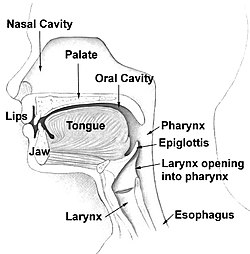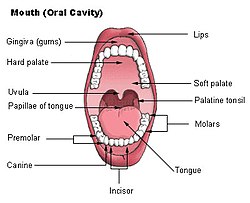The palate (pron.: /ˈpælɨt/) is the roof of the mouth in humans and other mammals. It separates the oral cavity from the nasal cavity. A similar structure is found in crocodilians, but, in most other tetrapods, the oral and nasal cavities are not truly separate. The palate is divided into two parts, the anterior bony hard palate, and the posterior fleshy soft palate or velum. The maxillary nerve branch of the trigeminal nerve (V) supplies sensory innervation to the palate.
The hard palate forms before birth. If the fusion is incomplete, it is called a cleft palate. As the roof of the mouth was once considered the seat of the sense of taste, palate can also refer to this sense itself, as in the phrase "a discriminating palate". By further extension, the flavor of a food (particularly beer or wine) may be called its palate, as when a wine is said to have an oaky palate.
Function
When functioning in conjunction with other parts of the mouth the palate produces certain sounds, particularly velar, palatal, palatalized, postalveolar, alveolo-palatal, and uvular consonants.

Hard palate
The hard palate is a thin horizontal bony plate of the skull, located in the roof of the mouth. It spans the arch formed by the upper teeth.
It is formed by the palatine process of the maxilla and horizontal plate of palatine bone.
It forms a partition between the nasal passages and the mouth. Also on the anterior portion of the roof of the hard palate is the Rugae which are the irregular ridges in the mucous membrane that help facilitate the movement of food backwards towards the pharynx. This partition is continued deeper into the mouth by a fleshy extension called the soft palate.
Function
The hard palate is important for feeding and speech. Mammals with a defective hard palate may die shortly after birth due to inability to suckle (see Cleft below). It is also involved in mastication in many species. The interaction between the tongue and the hard palate is essential in the formation of certain speech sounds, notably /t/, /d/, /j/, and /ɟ/.

Soft palate
The soft palate (also known as velum or muscular palate) is, in mammals, the soft tissue constituting the back of the roof of the mouth. The soft palate is distinguished from the hard palate at the front of the mouth in that it does not contain bone.
Function
The soft palate is movable, consisting of muscle fibers sheathed in mucous membrane. It is responsible for closing off the nasal passages during the act of swallowing, and also for closing off the airway. During sneezing, it protects the nasal passage by diverting a portion of the excreted substance to the mouth.
In humans, the uvula hangs from the end of the soft palate. Research shows that the uvula is not actually involved in snoring processes. This has been shown through inconsistent results from uvula removal surgery. Snoring is more closely associated with fat deposition in the pharynx, enlarged tonsils of Waldeyer's ring, or deviated septum problems. Touching the uvula or the end of the soft palate evokes a strong gag reflex in most people.
Speech
A speech sound made with the middle part of the tongue (dorsum) touching the soft palate is known as a velar consonant.
It is possible for the soft palate to retract and elevate during speech to separate the oral cavity (mouth) from the nasal cavity in order to produce the oral speech sounds. If this separation is incomplete, air escapes through the nose, causing speech to be perceived as nasal.

No hay comentarios:
Publicar un comentario